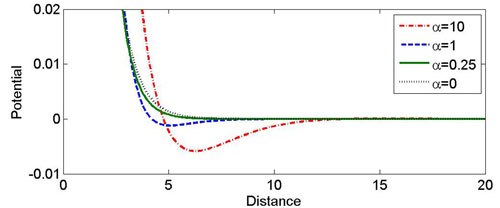| Mar 26, 2012 |
When ions get closer
|
|
(Nanowerk News) Nowadays, ever smaller and more powerful computer chips are in demand. RUB physicists have discovered a new physical attraction that accelerates this progress. Prof. Dr. Padma Kant Shukla and Dr. Bengt Eliasson found a previously unknown phenomenon in quantum plasmas. A negatively charged potential makes it possible to combine positively charged particles (ions) in atom-like structures within the plasma. In this way, current can be conducted much more quickly and efficiently than before, opening new perspectives for nanotechnology. The researchers report on their findings in Physical Review Letters ("Novel Attractive Force Between Ions in Quantum Plasmas").
|
 |
| The figure shows the interaction potential for different alpha, which measures the relative strength of the quantum recoil effect compared to the sum of the quantum-statistical pressure and electron-exchange/electron correlations effects. (© B. Eliasson / P. Shukla)
|
|
Electrons and ions in ordinary plasmas
|
|
An ordinary plasma is an ionized electrically conducting gas consisting of positive (ions) and negative charge carriers (so-called non-degenerate electrons). This is the chief constituent of our solar system. On Earth, such plasmas among others can be used to produce energy in controlled thermonuclear fusion plasmas similar to the sun, or even to fight disease in the medical application field.
|
|
New effect on the atomic scale in quantum plasmas
|
|
Quantum plasmas extend the area of application to nano-scales, where quantum-mechanical effects gain significance. This is the case when, in comparison to normal plasmas, the plasma density is very high and the temperature is low. Then the newly discovered potential occurs, which is caused by collective interaction processes of degenerate electrons with the quantum plasma. Such plasmas can be found, for example, in cores of stars with a dwindling nuclear energy supply (white dwarfs), or they can be produced artificially in the laboratory by means of laser irradiation. The new negative potential causes an attractive force between the ions, which then form lattices. They are compressed and the distances between them shortened, so that current can flow through them much faster.
|
|
Microchips and semiconductors
|
|
The findings of the Bochum scientists open up the possibility of ion-crystallization on the magnitude scale of an atom. They have thus established a new direction of research that is capable of linking various disciplines of physics. Applications include micro-chips for quantum computers, semiconductors, thin metal foils or even metallic nano-structures.
|
|
|

